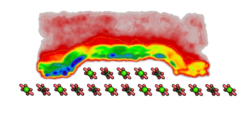Additive Directed Crystal Growth
Soluble additives are one of the most important means of controlling the growth of crystals, as they influence morphologies, size and size distributions or, alternatively, they inhibit unwanted crystallisation. Certain additives can also become incorporated within crystals, providing a novel route for modifying properties and functionality.
In this area of the Project we are investigating the effects that a range of additives have on crystal growth and the properties of the resulting crystals. We evaluate the properties of additives that will slow growth, modify morphology or lead to incorporation into the growing crystal, and the growth conditions that enhance these effects. We employ state-of-the-art experimental techniques, such as Atomic Force Microscopy (AFM), scanning ion conductance microscopy (SICM) and combined SICM and scanning electrochemical microscopy, to provide a holistic view of the effect of additives on the growth kinetics and speciation around single microcrystals. We complement the experiments with advanced modelling that uses rare event methods to calculate interactions and residence times of the additives on surfaces, and we use this information to develop comprehensive kinetic Monte Carlo models of crystal growth in the presence of additives. These models will ultimately enable us, not only to understand the fundamental mechanisms of additive directed growth, but also to use additives to grow crystals with desired properties.

